- Introduction
- Report Readers
-
Report Authors
- Standalone Designer
- WebDesigner
- Report Types
- Report Controls
- Report Wizard
- Data Binding
-
Design Reports
-
Design Page/RDLX Reports
- Layout
- Report Dialog
- Master Report (RDLX Report)
- Layers
- Expressions
- Data Visualizers
- Filters
- Groups
- Interactivity
- Scripts
- Report Appearance
- Tutorials: Report Controls in Page/RDLX Reports
-
Tutorials: Page/RDLX Report Scenarios
- Create RDLX Dashboard Report
- Create Multi-Column Layout (or Columnar report)
- Create Top N Report
- Create a Red Negatives or a Green Bar Report
- Apply Theme at Runtime Using Dynamic Expression
- Add Page Numbering
- Show Row Number in Tablix and Table
- Link Multiple Datasets to Same Data Region
- Localize RDLX Report Content
- Design Section Reports
-
Design Page/RDLX Reports
- DevOps
- Developers
- Samples
- Troubleshooting
Create Multi-Column Layout (or Columnar report)
This topic describes creating a columnar report layout in RDLX and Page reports.
RDLX Report
There are two ways to create a Columnar layout in an RDLX report.
Using RowsOrColumnsCount and Count properties of the List data region
List data region available in Page and RDLX reports (RDLX and RDLX Dashboard), supports generating multiple columns or rows with the help of the following properties:
RowsOrColumnsCount, which is the number of rows or columns (By default = 1)
GrowDirection, which is the list layout grow direction (Row, RowReverse, Column (default), ColumnReverse)
If the GrowDirection = Column and the Count = number of columns say 4, then the data is rendered horizontally in 4 columns. The rest of the list is populated based on the data region's fixed size. Also, if the GrowDirection = Row and the Count = number of rows say 8, then the data is rendered vertically in 8 rows. The rest of the list is populated based on the data region's fixed size.
RowsOrColumnsCount=4 and GrowDirection = Column
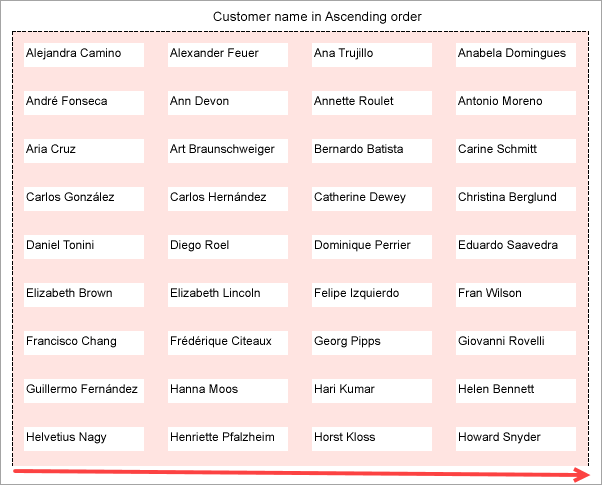
RowsOrColumnsCount=4 and GrowDirection = ColumnReverse
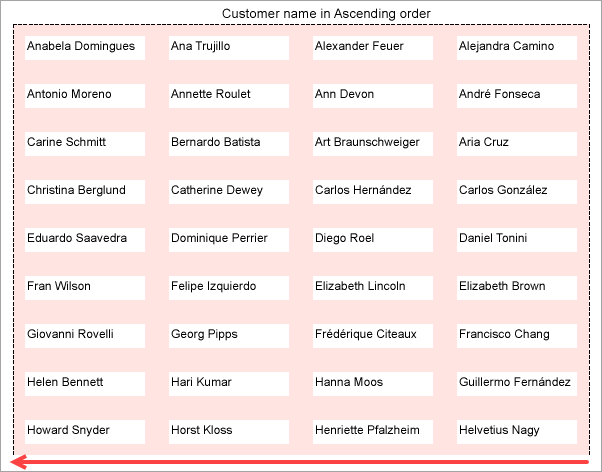
RowsOrColumnsCount=8 and GrowDirection = Row
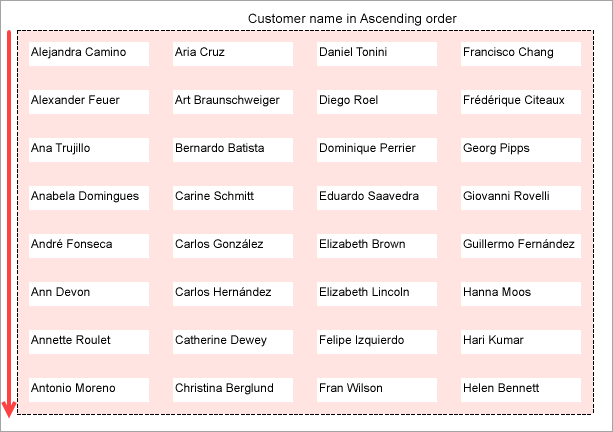
RowsOrColumnsCount=8 and GrowDirection = RowReverse
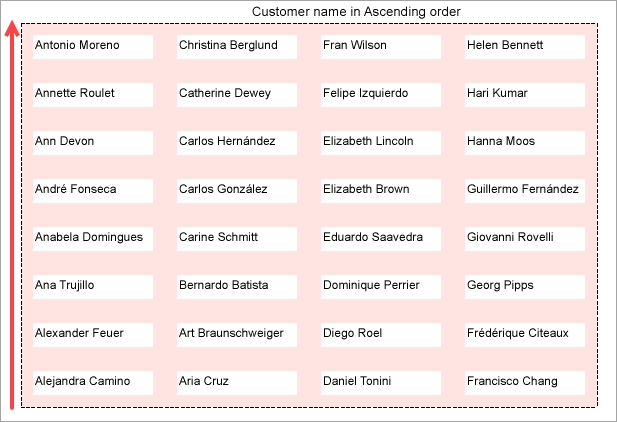
Go through the tutorial on Create Gauge Chart, which provides step-wise instructions on how a multi-column list layout is used for gauge charts to display the units in stock in each category of products.
Using the Columns property of the Report's Body
This section talks about creating a columnar report layout in an RDLX report by using the Columns property of the report's Body.
The final report will look as shown.
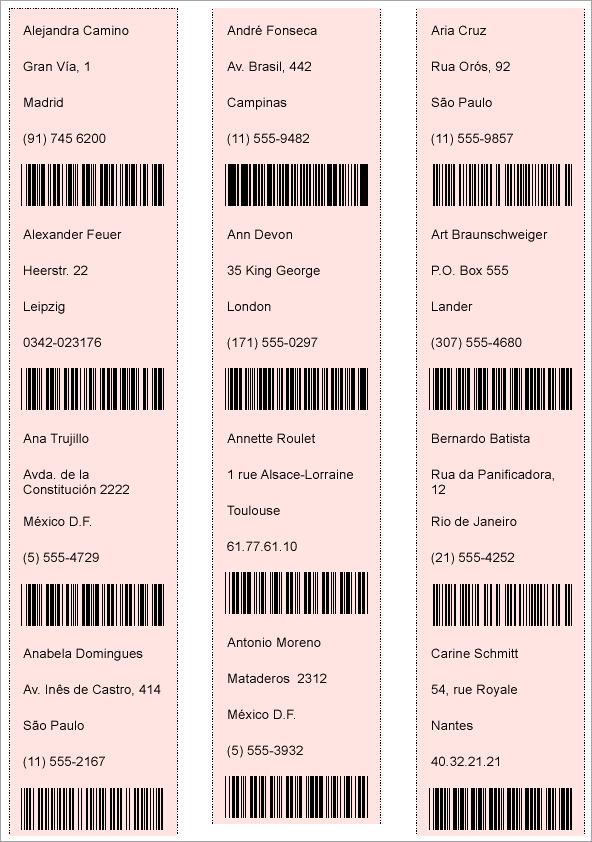
Create a Report
In the ActiveReports Designer, create a new RDLX Report.
##### Bind Report to Data
As you create a new report, the Report Data Source dialog appears for you to configure the report data connection. You can also access this dialog by right-clicking the Data Sources node in the Report Explorer and then selecting the Add Data Source option.
In the dialog, select the General page and enter a name for the data source.
Select 'SQLite Provider'. See Configure ActiveReports using Config file for more information.
Enter the Connection String similar to the following based on the location of nwind.db file:
data source= C:\data\nwind.db;Click OK.
In the DataSet dialog that appears, set the Name as 'DataSet1'.
Go to the Query page and enter a query in the Query textbox in the following format:
Select * from Customers order by ContactNameClick the Validate DataSet icon
 to validate the query. If there is no warning, it means the query is validated. Then click OK to close the dialog.
to validate the query. If there is no warning, it means the query is validated. Then click OK to close the dialog.
Design Report Layout
##### Create a Column Layout for the Report
In the Report Explorer, select Body.
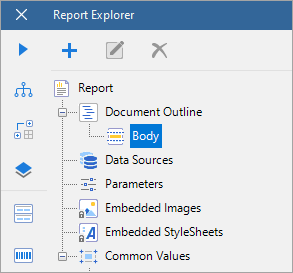
Set the following properties in the Properties panel:
Property Name
Property Value
Columns
3
ColumnSpacing
0.10in
Size
2in, 2.15in
##### Populate Data in Report
Drag and drop the List data region onto the design surface.
Go to Report Explorer, expand the DataSet1 node, and drag and drop the following fields inside the List data region, one below the other, with their Value property set to the following fields:
=Fields!ContactName.Value
=Fields!Address.Value
=Fields!City.Value
=Fields!Phone.Value
From the toolbox, drag and drop the Barcode control below =Fields!Phone.Value field, inside the List data region, and set its Value property to =Fields!PostalCode.Value.
Ensure that the DataSetName property of the List data region is set to 'DataSet1'.
You will also need to adjust the Size (for example, 1.75in, 2.125in in our case) of the List data region to accommodate the data in the specified columns.
Set the BackgroundColor property of the list to say, 'MistyRose'.
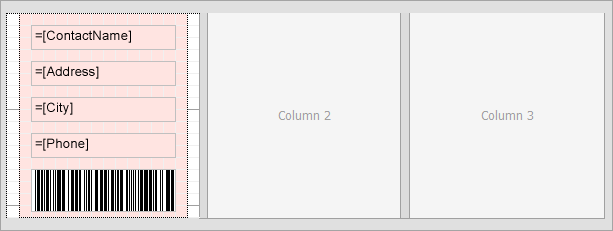
Improve the appearance of the report.
Preview Report
The final report is shown here.
Page Report
There are two ways to create a Columnar layout in Page report.
Using RowsOrColumnsCount and Count properties of the List data region
List data region can be used in Page report in a similar way as RDLX report, to create columnar reports, such as an address labels report. See this Create Address Labels in Page Report topic for details on creating a columnar report.
Using OverflowPlaceholder control
See Create Columnar Reports with OverflowPlaceholder Control topic for details.


